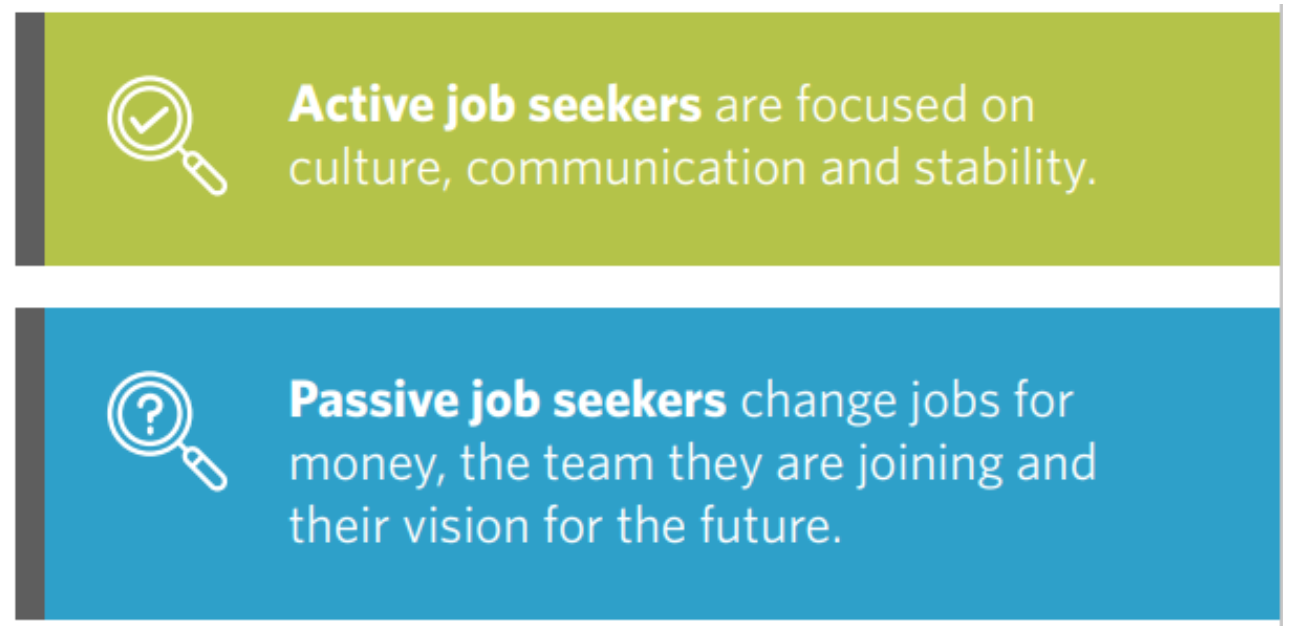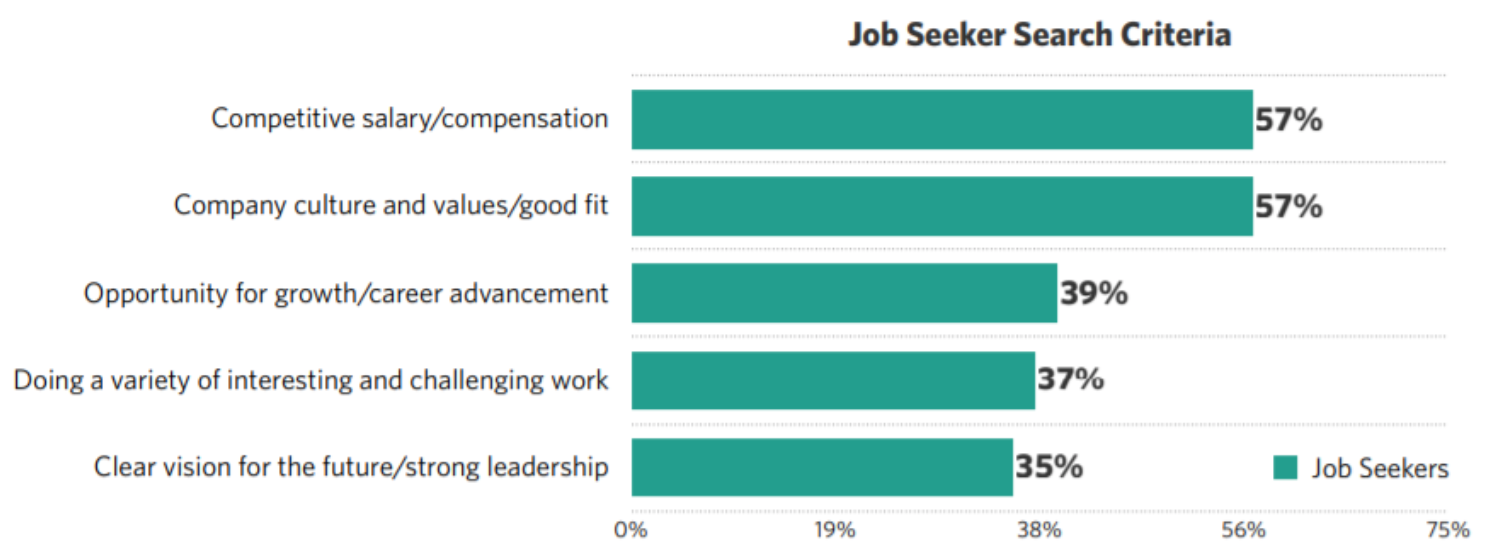The idea of a rock-solid employee recruitment strategy that reliably attracts and retains top talent sounds more like a dream than it does an achievable reality. But even as HR departments face the stresses of the “Great Resignation” – and the endless departure of retirees – Hinge research shows that agile professional services firms can transform their most pressing recruitment challenges into exciting hiring opportunities, simply by leveraging a few key tips from our employer branding playbook.
In truth, some of the most sought-after professionals in your industry are searching for a better place to work right now. Your mission, should you choose to accept it, is to attract these employees into your organization – and this “10-Minute Survivor’s Guide to Winning the Talent Wars“ will show you how to do it, while keeping your existing team satisfied, engaged, and more productive than ever.
In the 10 minutes it takes to read this guide, you’re going to learn:
- What an employee recruitment strategy is;
- The benefits of developing a talent recruiting strategy;
- The importance of research-based recruitment strategies;
- 9 research-proven employee recruitment strategies that work; and, finally,
- How to retain top talent after hiring them.
What Is an Employee Recruitment Strategy?
An employee recruitment strategy is a plan for attracting and retaining the talent required to execute your overall business objectives. An effective employee recruitment strategy consists of two essential elements: (1) the identification of the talent sets you need; and (2) the process that attracts, screens, onboards, and retains the people who possess these talent sets.
What Are the Benefits of Establishing an Employee Recruitment Strategy?
Our research shows that a clearly defined employee recruitment strategy offers the following benefits and advantages:
- Clearly communicates the recruitment strategy: Codifying your talent recruitment strategy makes it easier to communicate the details of the strategy to all staff involved in the recruitment process. When everyone is on the same page, your team can work in synergy to support the larger hiring needs of your organization.
- Serves as an essential element of your growth strategy: As the size and profitability of your company grows, your staffing and recruitment requirements will expand with your organization. Therefore, every growth strategy should include a corresponding recruitment strategy.
- Documents and tests your assumptions: The first iteration of your recruitment strategy is a “work in progress” that will require continuous adjustments. Codifying the strategy with your team allows you to standardize the implementation of your assumptions and test them for efficacy. As elements of the strategy prove or disprove themselves over time, you can document changes while keeping all team members on the same page.
- Measures desired outcomes and troubleshoot solutions: A good recruitment strategy empowers you to measure your recruitment actions against desired outcomes, so you can troubleshoot solutions and improve the overall efficacy of the strategy.
The Importance of Research-Based Recruitment Strategies
Some of the most common recruitment tactics – even some that you’ll learn at HR conferences – do not have any foundation of evidence to prove that they work. Other common methods may have worked in the past, but they no longer produce the results you need in a contemporary hiring context.
With this in mind, it’s important to understand that some – if not all – of your recruiting ideas, habits, and assumptions might not be effective. They could even be working against the hiring goals you’ve set out to achieve. Through careful research – and critically examining how your hiring practices are performing – you can better identify the strategies that work and the ones that don’t. Over time, you can adjust your tactics to make sure they’re working based on reality as discovered through research.
9 Research-Proven Employee Recruitment Strategies That Work
At Hinge, we developed the following research-proven recruitment strategies from key insights in our Employer Branding Study:
1. Get to Know Your Targeted Talent
The recruitment strategies that attract one type of employee could serve to dissuade another type of employee from wanting to join your firm. Therefore, the first step toward developing a sound talent recruitment strategy is to understand the specific needs and priorities of the talent you’re targeting.
Just as marketing firms develop detailed customer profiles, your goal is to create a clear picture of your ideal job candidate and what they look for in an employer. Once you have that picture, you can adjust your recruitment strategies to attract these employees.
As an example, our Employer Branding Study offers the following insights into the different priorities of entry-level versus mid-career job seekers:
Entry-level professionals seeking jobs:
- Most are aged between 25 and 34.
- The only career level to prioritize both salary and professional growth equally as the top deciding factors.
- Prioritize nearby jobs that don’t require excessive travel or relocating.
- Search for jobs via company web pages, social media, job fairs, job boards, and educational facilities.
Considering this information, firms that want to attract entry-level candidates may want to focus on local recruitment activities while clearly communicating the growth and advancement opportunities available to entry-level hires.
Mid-career professionals seeking jobs:
- Most are aged between 35 and 44.
- Seek positions with greater responsibility.
- Value workplaces with cultures of respect and honesty more than other career levels.
- Want to know that they will receive recognition and appreciation for their contributions.
- Prioritize salary first, company culture second, and “companies with a clear vision for the future” third.
- Concerned about being “stretched too thin” and “wearing too many hats.”
- Search for jobs via recruiters, staffing firms, trade associations, and referrals from friends and colleagues.
- Prefer human-centric job search methods over online job platforms.

Source: Employer Branding Study Executive Summary
Considering this information, firms that want to hire mid-career candidates may want to clearly communicate their workplace cultural values – especially as they relate to respect and honesty. Job descriptions should be clearly defined and reference more focused roles. Finally, during interviews, companies should provide evidence that they recognize team members for their contributions.
2. Target Passive Job Candidates
Active job seekers are the ones that come knocking on your door, making them the easiest and most convenient employees to hire.
In contrast, passive job seekers are interested in new opportunities but they’re not actively searching for jobs. They could be working at a competitor, taking leaves of absence, or they might be taking it easy after losing their jobs in the pandemic. There are plenty of passive job seekers available in this market – but employers have to be proactive in reaching out to them.
Interestingly, our employer branding study showed that passive job seekers have dramatically different employment priorities than active job seekers:
- Active job seekers: Prioritize career growth opportunities, a great professional culture, good communication, and they prefer jobs that offer stability.
- Passive job seekers: Prioritize better pay, a strong sense of connection with fellow team members, and they want to join firms with a clear vision for the future.

Source: Employer Branding Study Executive Summary
By understanding the different priorities of passive job seekers – and the fact that passive job seekers are more prevalent than active ones at this time – HR teams can strategically adjust the way they present their firms when reaching out to passive candidates.
By stressing the points that passive job seekers prioritize – such as competitive salaries, a close-knit team environment, and an impressive corporate vision – our research shows that firms will have a better chance of convincing these job candidates to join their teams.
3. Assess Your Employer Brand
What is the experience like as an employee working at your firm, and what are people outside the company saying about the work experience? When you find the answers to these questions, you’ll have an excellent assessment of your current employer brand. Are you happy with it? Does something need to change to attract the top talent you need?
Beyond the most general aspects of your employer brand – such as having a reputation for being “an excellent place to work” – there are more specific elements. For example, your employer brand could be known for any number of positive or negative attributes:
- Negative: Having a high-pressure culture where employees have to work late at night.
- Positive: Offering a full month of paid vacation to employees who have been there for more than three years.
- Negative: Being stingy on year-end bonuses and vacation days.
- Positive: Providing a fully stocked breakroom with the best free snacks and drinks.
- Negative: Having a highly critical culture where micromanaging is the norm.
- Positive: Having a culture of respect and honesty where all employees get to participate in important management decisions.
- Negative: Having limited resources and out-of-date technologies.
- Positive: Being a place where new grads find exciting opportunities to grow their careers.
- Mixed: Having a competitive hiring process where only the best candidates can get a job.
Employer branding also refers to how your company is perceived by different industries, groups of employees, universities, and referral sources. For example, your company could be well-known among top-tier law school graduates as a coveted place to work, while less prestigious law school students see your firm as “overly pretentious” because it only gives opportunities to ivy league grads.
At Hinge, our Employer Branding Program assists firms in the process of developing a powerful employer brand that attracts top talent. The first step in this process is the careful and honest assessment of your reputation as an employer. After we get to the heart of what people are really saying about working at your firm, we can identify cornerstone employer branding elements that – once addressed – will transform your organization into a place where the most talented individuals in your industry are proud to be employed.
Learn more about the Hinge Employer Branding Program here.
4. Tune Up Your Culture and Communicate It
According to our employer branding research, an attractive salary is a top consideration among prospective employees. However, the desire to find an excellent cultural fit also carries a lot of weight. For example, our research shows that job candidates predominantly want to work at companies with a culture that values honesty and respect – while also supporting the career growth of their employees.

Source: Employer Branding Study Executive Summary
Does your firm need a culture tune-up? At Hinge, we’ve found that the most effective way to tune up your culture is to focus on one priority instead of a dozen. By focusing your culture tune-up on a single, powerful element, you can master this element in a way that truly sets your workplace apart from other firms.
For example, what if your company culture lacks a sense of warmth, compassion, and respect among team members? Managers can make it their mission to start remembering key details about the closest family members of their employees. By remembering the names, ages, and interests of family members, managers can weave these details into conversations to radically boost the sense of family, warmth, and trust throughout the organization.
After implementing a cultural tune-up like this, make sure you’re communicating the new values to job candidates. Weave “culture” into interviews by explaining why these values are important to your firm. Also, talk about your company culture in visible places – such as your website, social media pages, and marketing material – so job candidates see this information while researching your company.
5. Showcase Your Expertise
Another top selection factor among job candidates is the degree of industry expertise your business possesses. Ultimately, your best recruits are looking for the same thing as your clients – an established, specialized company with strong industry expertise where they can work alongside respected and visible experts.

Source: Hinge Marketing Library, The Visible Expert Revolution
Here are some easy ways to showcase your firm’s industry expertise to new job candidates:
- Showcase visible experts at your company: Encouraging your expert team members to teach public classes, give presentations at conferences, and write blogs that potential job candidates will see. If you don’t have “visible experts” on staff, our new book – “The Visible Expert Revolution” – is a comprehensive yet accessible guide any expert can use to raise their profile and achieve extraordinary success.
- Display team members and their biographies on company web pages: Spend time on team member biographies to ensure that they communicate the depth of experience team members have, and share their stories on websites and social media.
- Share firm achievements with job candidates: Make a list of your firm’s most noteworthy achievements and its prestigious clientele. Share this information on social media, in job vacancy listings, and with new job candidates during interviews.
- Share firm achievements with current employees: Post your firm’s achievements on bulletin boards around the office to remind current team members that their company is highly regarded for its expertise. They will share this information with colleagues and friends outside your organization.
6. Introduce Job Candidates to Your Team
Most companies only allow key decision-makers – like managers and HR personnel – to meet new job candidates during the recruitment phase. This is a mistake; job seekers want to know who they’re going to work with before they accept your job offer.
During interviews, consider talking about individual team members, their achievements, and the common interests they share – and let new recruits meet their future co-workers ahead of time. When job seekers feel a connection with the team they’re going to work with, they’ll feel a lot more comfortable accepting your offer.
7. Leverage Social Media
According to our employer branding study, professional services job candidates use LinkedIn and other social media websites to evaluate their employers. Therefore, it’s essential that your company’s descriptions and posts on social media convey the right employer branding message to future job candidates. Check these sites carefully to ensure that they’re not just speaking to your customers, but also to your future employees.
Video posts are an excellent way to boost the quality of your social media presence. Consider posting videos of your employees talking about why they enjoy working with your company. This will help future job candidates feel closer and more comfortable with your organization and team.
8. Embrace the Niches
Most businesses offer a mix of general and extremely niche services to their industries. The general services your company offers might be your “bread-and-butter,” but your niche services are probably the most interesting and memorable that set your firm apart.
Make sure to identify the niche services your company offers. Post job listings on niche job boards and communicate your most exciting niche specializations to new recruits.
For example, a personal injury law firm might generate most of its income from litigating workers’ compensation claims. But it could be notorious for winning asbestos-related lawsuits, and maybe the nation’s leading asbestos litigation expert is an employee at the firm. As an attractive niche that makes the company stand out among job candidates, the law firm may want to showcase this niche in job postings and interviews.
9. Get the Professional Help You Need
Last but not least, if you’re having a hard time attracting new employees, you don’t have to struggle alone. Consider hiring a professional researcher, recruiter, recruitment trainer, or headhunter to help with your recruitment efforts. Oftentimes players with niche expertise can help you reach specialized talent pools that a general recruiter is unfamiliar with.
But don’t limit your efforts to recruiting help only. Consider retaining a firm that can help you assess your employer brand and evaluate what cultural adjustments can have a major impact on your recruiting success. As more research comes out, you’ll be able to zero in on the changes that will make the most sense for your firm.
Finally, remember that recruiting and retaining is very much a marketing endeavor, so don’t forget to include your marketing team and pay special attention to your website. Arguably, the most important consideration is search engine optimization (SEO) so that you’re found in the first place for the expertise that your firm already possesses. This also helps you understand how you’re viewed as a workplace. If you don’t have these specialized talents on board, retaining them can have a big impact on your ultimate success in winning the talent wars.
Retain Top Talent by Addressing Resignation Triggers
Equally important to attracting and hiring top talent is keeping your employees on staff. Understanding the circumstances that trigger resignations in today’s marketplace, avoiding them, and preparing for them ahead of time is an excellent way to boost your employee retention figures.
According to our employer branding study, these are leading factors that trigger employee resignations in today’s marketplace:
- Your firm employs a large number of workers who have been in their positions for 3 to 4 years: Professional staff members are most likely to leave between their third and fifth years of employment. Therefore, organizations should pay close attention to these employees. Talk to them, learn about their needs, and find out how you can make their work experiences better.
- Your firm operates in a professional services industry: Departing baby boomers, COVID-19 stresses, and increasing numbers of mergers and acquisitions have hit professional services jobs particularly hard. Now more than ever, professional services firms need to build their employer brands while implementing solid employee recruitment strategies.
- Your firm has experienced an event that triggers resignations: According to our employer branding study, events surrounding the COVID-19 pandemic and the rising number of corporate mergers and acquisitions were important triggers for professional services resignations. A significant number of employees who were actively seeking new jobs said that they were dissatisfied with their firm’s management of either COVID-19 or a recent merger and acquisition event.
- Your team members are unwilling to recommend your company as a place to work: When team members will not recommend your workplace to friends and family members, it’s a clear sign that employees are not satisfied with their work experience and the loss of top talent could be on the horizon.
A Final Thought
Now that you’ve finished this guide, you should have some excellent, research-based employee recruitment strategies that will help you attract and retain the best employees during these difficult times.
Even as the battle for top talent intensifies – due to COVID-19, rising mergers and acquisitions, retiring baby boomers, and the “Great Resignation” – the recruitment strategies in this guide can give your organization the competitive edge you need. However, if you’d like to supercharge your talent-attracting abilities even more, Hinge is here to help.
How Hinge Can Help
Our research-based Employer Branding Program positions your firm to attract the best employees while developing your company’s brand as a sought-after workplace. From research, to strategy, to implementation, Hinge will guide you through the employer rebranding process to achieve exceptional talent acquisition results.
Additional Resources
- The Hinge Employer Branding Study offers a detailed look into today’s highly competitive “employer’s marketplace” while outlining fine-grained strategies for employee recruitment success.
- Watch our on-demand webinar, The Great Resignation Trend: How Can You Adapt to Better Acquire and Retain Talent?




